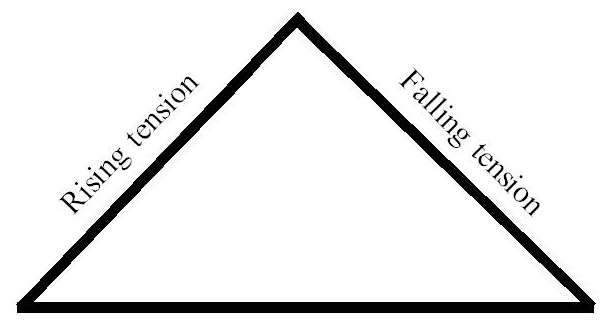Can a story work without a structure?
Of course not.
But a structure itself is not a plot.
A structure is a Holiday Inn. A plot is a Gaudi cathedral. It has twists, turrets, flying buttresses…
So how do we find a plot?
The instinctive way is to start with a strong idea, incident or character. Introduce conflict. Then see what happens.
That’s still not a plot. It’s a game of marbles. After the event, we spend a lot of time discarding junk.
No, marbles is out.
Are there better methods of how to plot a story? Ever since a bard stood up in a Stone Age cave, pundits have created plotting systems.
In 1863, Gustav Freytag devised his famous pyramid.

It purports to define the rise and fall of tension in a story, but works only in classical Greek drama.
Georges Polti became a legend in 1895 with his 36 Dramatic Situations. But there were hundreds more, he conceded. Just patch one dramatic situation onto another.
William Wallace Cook did exactly that in 1928 with Plotto. It lists thousands of basic plots across 550 small-print pages, but the permutations are almost infinite. Plotto works. Hitchcock swore by it. So did Erle Stanley Gardner. It helped him dictate 66,000 words of Perry Mason stories every week.
Problem is, Plotto is tough to use.
Christopher Booker thought he’d found the answer with The Seven Basic Plots (2004). He mapped stories onto ancient myths and showed why Star Wars — and so many other movie epics — became blockbusters. Their patterns are wired into our DNA.
Take one of his Basic Plots: The Quest. It’s the theme of Pilgrim’s Progress, the Odyssey, Watership Down, Raiders of the Lost Ark… and Star Wars.
Thank you, Mr Booker, but mythic themes–by themselves–don’t help us. We want a plot.
Where do we get one?
Stop thinking Words. Start thinking Pictures!
As a random example, let’s start with The Quest. It’s a search for something — perhaps a precious object, lost or promised. That theme is timeless. It comes with reader appeal built in.
The object of our Quest might be a will, secret formula, military plan, map to a buried treasure, scandalous love letter… even a lost cat. Its discovery will change people’s lives, for better or worse. And maybe some don’t want it found.
That’s a source of conflict, all by itself.
How can we use the epic theme of the Quest to create a gripping story about… a cat? Let me count the ways. I’ll start with seven but there are many more. (And I’ll show you how to find them.)
Each of these seven strategies derives from a picture.
The Quest theme and cat are merely examples. They’re elements in a picture. Look at the shape behind each picture. It will suggest new ways you can craft a story plot, in any genre that you wish.
For simplicity, let’s imagine just four central characters:
Alice, an elderly lady; Sharon, her daughter; Ned, their jobbing gardener; and Estella, a pampered Persian cat.
Now we’ll put them into plots based on pictures.
1. The Rugby Game
 This story moves from one narrator to another, and back again, in a game of pass the ball.
This story moves from one narrator to another, and back again, in a game of pass the ball.
Scene 1. We see Alice lamenting the loss of her cat. “Has Estella been abducted?”
Scene 2. The point of view switches to her overworked daughter Sharon who suggests that the spoiled pet has merely taken a holiday. “Cats can look after themselves,” she says. And adds beneath her breath, “I wish old ladies could.”
Scene 3. We move into the mind of Ned, the gardener. He hopes fervently the cat won’t come back. He’s tired of the beast wrecking his flower bed.
Scene 4. We switch to the author’s viewpoint and see the cat, purring complacently in the flower bed. It’s had its fun. Time to come home, it thinks.
Scene 5. The story closes in Ned’s point of view. He removes the cat’s identity tag. He phones a local cat home. “Can you take delivery of a stray cat? It’s ruining my flower bed. No, you don’t need my name…”
As the viewpoint switches back and forth, like a rugby ball, we see into each character’s mind. We view their private opinions of each other. The cat is simply a pretext for a tale of human conflict, farcical or sad.
2. The Kaleidoscope
 This story is given a big shake in the last scene. Each element drops back into a different pattern. We realize that everything we were told before was a lie. Our narrator has been unreliable!
This story is given a big shake in the last scene. Each element drops back into a different pattern. We realize that everything we were told before was a lie. Our narrator has been unreliable!
So the tale above might be related entirely from one viewpoint, that of Ned.
He shows us persuasively how he has helped the ladies look for the lost cat, stuck Wanted posters on every lamp post, and commiserated with them mightily. We think “What a nice man!”
The ladies, who had previously disdained him as a grubby oaf, see him in a new light.
In the last scene, the kaleidoscope gets a big shake. A chuckling Ned reveals to the reader (but to nobody else) that he had abducted Estella and taken her to a cat sanctuary. At last, he’s got his garden back!
The wicked man.
Shake the kaleidoscope well and the surprise in the closing lines will leave your reader breathless.
3. The Switchback
This story shifts continually between crisis and relief, tension and tranquility — like the beat of a human heart.
Scene 1. The cat is lost. (Tension.)
Scene 2. Rumours come that she has been found safe and well by a kindly neighbor. (Relief.)
Scene 3. On inspection, the cat is not Estella! (Tension.)
Scene 4. A vet reassures the ladies that cats can survive perfectly well in the wilds. Estella will come home when she wants to. (Relief.)
Scene 5. A local newspaper reports that a nearby Chinese restaurant has been closed down by Food Hygiene inspectors after cat fur was found in its meat. (Horror! Has Estella met a culinary fate?)
Scene 6. It turns out to be a false alarm. (Relief.)
And so on.
The Switchback pattern can be sustained for as long as you wish, until the cat is found or not found, or you reach your desired word count. Sub-plots emerge, conflicts develop, marriages collapse… Potentially, there’s a whole novel here, for cat lovers.
4. The Nautilus Shell
 Have you seen the pattern of a Nautilus shell, sliced in half? The spiral swirls towards its centre and every cell has another cell adjacent to it. Map that onto a story. As the tale winds to its close, the narrative timeline continually flashes forward then flashes back.
Have you seen the pattern of a Nautilus shell, sliced in half? The spiral swirls towards its centre and every cell has another cell adjacent to it. Map that onto a story. As the tale winds to its close, the narrative timeline continually flashes forward then flashes back.
Scene 1. Flashback five years. Alice has acquired the cat to keep her company after her husband’s death. (A slow poignant scene.)
Scene 2. Return to main timeline. Estella has vanished. (The pace quickens.)
Scene 3. Flash forward three years. Alice is relaxing in her garden, quietly thinking back to that tragic moment when Estella vanished. The scene is tranquil but contains a teasing question – did she ever recover the cat? – to encourage the reader to read on.
Scene 4. Return to main timeline. The cat is being hunted everywhere. A vast reward is offered. Cruel hoaxes and false alarms raise the tension.
Scene 5. Flashback to the day before the cat disappeared. Alice is playing contentedly with Estella. (A slow nostalgic passage.)
Then we’re into the main timeline again as the frantic search for Estella continues.
Done skilfully, the Nautilus Shell pattern can endow a story with great suspense and depth.
Tip: To avoid confusing the reader, mark every shift in time and place very clearly. You could prefix each scene with a dateline: ‘The garden March 2012,’ etc. Or, more visibly, with stage directions: ‘It was March 2012 and the crocuses were already in full bloom…’
5. The Pink Thread
This is a term I’ve invented for a character or incident that appears early in the story and reappears at random intervals, but seems (at first) to be irrelevant to the plot. The crucial importance of the Pink Thread only becomes clear at the end.
Scene 1. A friendly postman arrives at Alice’s house, finds her in a state of shock over her missing cat, sympathizes with her and leaves. The man appears to have no function in the story except as a sounding board, a device for the reader to learn what has happened.
Scene 2 – ? A few scenes later, the postman turns up again, ostensibly to see if the cat’s been found. Again, he acts as a sounding board so the ladies can review – for the reader’s benefit – the events to date. The reader quickly forgets him.
Final scene. The postman turns out to be the culprit! He has abducted Estella to give to his disabled little daughter. The cat is found alive and well at the postman’s house and seems contented with her new home and owner.
Alice is faced with a moral dilemma. Should she take back her cat or leave her with the little girl, who will be inconsolable at her loss?
The Pink Thread is a useful strategy if your plot doesn’t – quite – come together at the end. Go back and drop in, here and there, an ‘inconsequential’ character or event. Return to this Pink Thread at the close. Now its plot significance becomes clear. It resolves a central mystery or ties the ends together.
6. The Round Robin
The story circles back to its starting point, having explored many adventures en route.
Scene 1. The cat goes missing.
Scene 2 – 9. The cat is hunted everywhere, to no avail. Crises and dramas occur, sub-plots emerge, red herrings abound…
Scene 10. The cat returns, by itself, purring happily. Ned, the gardener, tells Alice wisely, “Cats like a holiday now and again.” And he winks.
Final scene. The cat vanishes yet again. Déjà vu. But this time, Alice goes to bed without worrying. She puts food behind the cat flap every night. And she remembers Ned’s heavy wink. She grants him a holiday too.
The Round Robin pattern gives a story an inherent unity. But be sure to end the tale on a note of irony or accomplishment, whether upbeat or not. The character(s) have learned something on their journey and changed – just like a Greek hero returning from a Quest.
7. The Frame Game
 One narrator introduces a story which features another narrator, who tells the story. It’s a frame within a frame. The tale closes when the first narrator reappears and returns us, with satisfying finality, to the outer frame.
One narrator introduces a story which features another narrator, who tells the story. It’s a frame within a frame. The tale closes when the first narrator reappears and returns us, with satisfying finality, to the outer frame.
Scene 1. Sharon, the daughter, is narrator #1. She defines the first frame. Maybe she’s having her hair cut and styled and, having nothing else to do for an hour, tells the hairdresser of that terrible time when her mother lost her cat.
Scenes 2-? The tale itself is related, in the mother’s voice. Her story defines the second frame.
Final scene. Return to narrator #1. Sharon, her hair now done, tells the hairdresser how the story ended.
One value of the Frame Game is that the first narrator, who forms the outer frame of the story, can describe the context at the start – giving us information that’s not in the story – or deliver a punchline at the end.
“The saddest part of it is that Mother never did have a cat. It was all in her mind.”
The hairdresser presses her hand. “Dementia is a terrible thing, my dear.”
Who needs Polti’s 36 Dramatic Situations?
We can impose an almost infinite number of patterns – or pictures – on a story theme to create a working plot. Snowflakes, mosaic pavements, turreted castles, labyrinths… You need never again wonder how to plot a story.
For inspiration, we just need to look around us. Now.
Sitting in my study – now – what do I see? A wastebin! It has a provocative funnel shape…
Could it be a new story in the making?





















